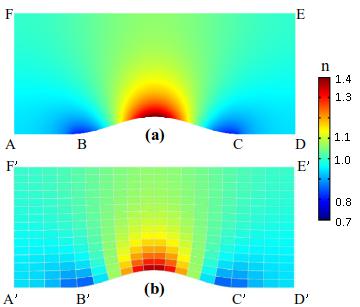
Acoustic carpet cloak is an invisible device that can conceal objects on a reflecting surface. The object wearing the carpet cloak would not be detected by acoustic beam. Thus, the acoustic carpet cloak plays an important role in applications of acoustic communication and detection.
The linear transformation method was proposed in 2008, however, it leads to enormous anisotropic parameters, making the carpet cloak difficult to match with the background medium independently and limiting the shape of the cloaked space.
Impedance matching is the biggest challenge of an underwater acoustic carpet cloak. To solve this problem, researcher YANG Jun and his team from the Institute of Acoustics (IOA) of the Chinese Academy of Sciences designed an underwater acoustic carpet cloak by penta-mode meta-fluid material, which is a kind of solid structure with fluid-like acoustic property where only the longitudinal wave can exist.
The research team theoretically calculated the parameters of the carpet cloak, and designed the unit cells with effective parameters closing enough to theoretical values. They chose aluminum as the substrate of the unit cells, and the cloak structure was obtained by assembling these unit cells after quasi-conformal transformation (QCT).
Comprised of aluminum hexagons, the designed carpet cloak realized impedance matching with water. The unit cells of the band were less than one-tenth of the wavelength in water, enabling it to work in the deep subwavelength scale.
In the simulation, the cases of rigid plane, penta-mode carpet cloak and rigid scatter were studied. For the rigid scatter case, the incident beam was scattered by the rigid bump on the plane so that the feature of the scattered waves could be noticed. The waves reflected by the carpet cloak retained a high similarity to that of the rigid plane, indicating that the designed penta-mode carpet cloak could conceal the object well.
Simulation results also showed that the proposed acoustic carpet cloak had good performance in a wide frequency range.
This work has potential application values in underwater acoustic detection. Furthermore, the deformation technique may shed light on the design of arbitrary shaped devices.
Published in Applied Physics Letters, the study was supported by the National Natural Science Foundation of China, the Youth Innovation Promotion Association CAS, and the IACAS Young Elite Researcher Project.

Figure 1. Profile of (a) the continuous refractive index and (b) the discrete approximation in the acoustic carpet. (Image by IOA)

Figure 2. The microstructure of the 2D pentamode materials and the final 2D pentamode material carpet cloak. (Image by IOA)

Figure 3. Numerical simulations, among which (a) (b) (c) (d) shows the scattering acoustic field for rigid plane, rigid scatter, theoretical acoustic cloaking and penta-mode acoustic carpet cloaking, respectively. (Image by IOA)

86-10-68597521 (day)
86-10-68597289 (night)

86-10-68511095 (day)
86-10-68512458 (night)

cas_en@cas.cn

52 Sanlihe Rd., Xicheng District,
Beijing, China (100864)

